Instructor Planning Guide
Activities
What activities are associated with this chapter?
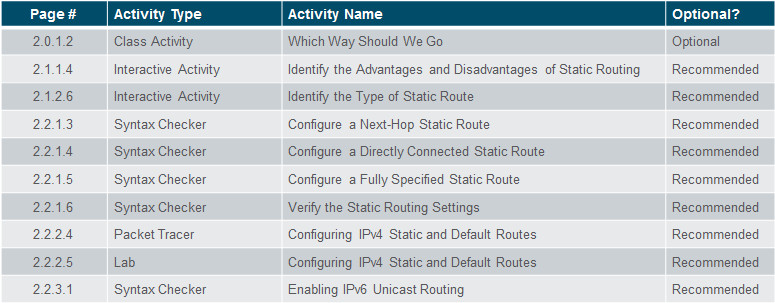
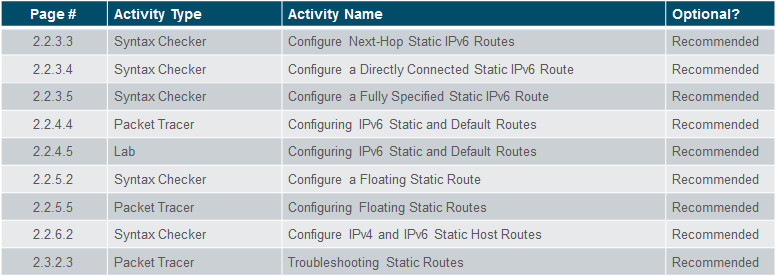

Assessment
Students should complete Chapter 2, “Assessment” after completing Chapter 2.
Quizzes, labs, Packet Tracers and other activities can be used to informally assess student progress.
Sections & Objectives
2.1 Static Routing Advantages
Explain how static routes are implemented in a small to medium-sized business network.
Explain advantages and disadvantages of static routing.
Explain the purpose of different types of static routes.
2.2 Configure Static and Default Routes
Configure static routes to enable connectivity in a small to medium-sized business network.
Configure IPv4 static routes by specifying a next-hop address.
Configure an IPv4 default route.
Configure IPv6 static routes by specifying a next-hop address.
Configure an IPv6 default route.
Configure a floating static route to provide a backup connection.
Configure IPv4 and IPv6 static host routes that direct traffic to a specific host.
2.3 Troubleshoot Static and Default Routes
Given an IP addressing scheme, configure IP address parameters on devices to provide end-to-end connectivity in a small to medium-sized business network.
Explain how a router processes packets when a static route is configured.
Troubleshoot common static and default route configuration issues.
Chapter 2: Static Routing
2.1 – Implement Static Routes
2.1.1 – Static Routing
2.1.1.1 – Reach Remote Networks
A router learns about remote networks in two ways:
Manually entered into the route table using static routes
Static routes are not automatically updated and must be reconfigured when topology changes
Dynamically (Automatically) learned using a routing protocol
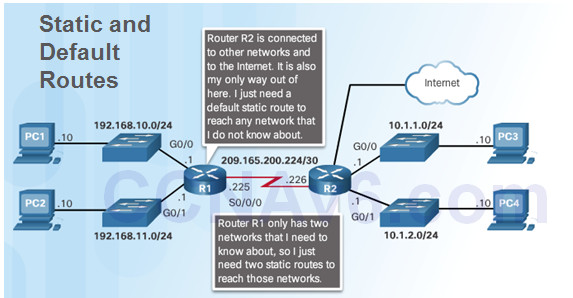
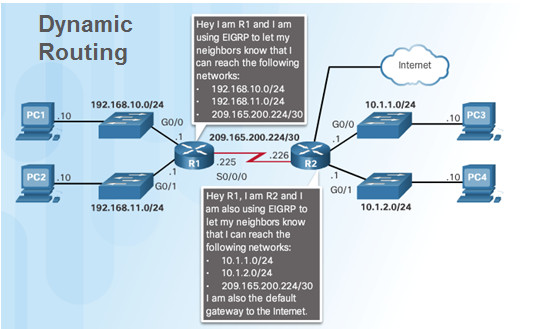
2.1.1.2 – Why Use Static Routing?

Dynamic versus Static Routing
2.1.1.3 – When to Use Static Routes
Three uses for static routes:
Smaller networks that are not expected to grow
Routing to and from stub networks
- Stub network accessed by a single route and has one neighbor
- 172.16.3.0 is a stub network
A single default route to represent a path to any network not found in the routing table
- Use default route on R1 to point to R2 for all other networks

2.1.2 – Types of Static Routes
2.1.2.1 – Static Route Applications
Use Static Routes To:
Connect to a specific network
Connect a stub router
Summarize routing table entries which reduces size of routing advertisements
Create a backup route in case a primary route link fails
2.1.2.2 – Standard Static Route
R2 configured with a static route to reach the stub network 172.16.3.0/24

2.1.2.3 – Default Static Route
Default route matches all packets and is used when a packet does not match a specific route in the routing table
Can be dynamically learned or statically configured
Default Static route uses 0.0.0.0/0 as the destination IPv4 address
Creates a Gateway of Last Resort
Common use is when connecting a company’s edge router to the ISP network
Router has only one router to which it is connected
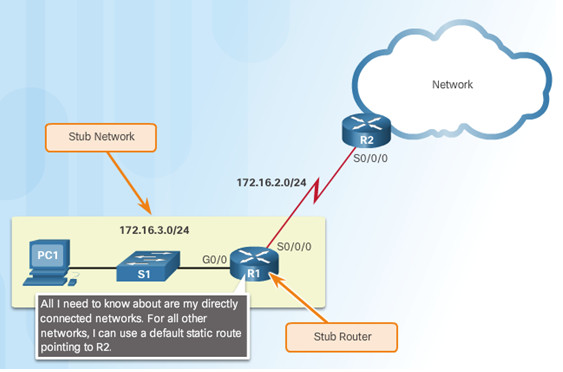
2.1.2.4 – Summary Static Route
Multiple static routes can be summarized into a single network address
- Destination networks must be contiguous
- Multiple static routes must use the same exit interface or next hop
- In figure, four networks is summarized into one summary static route

2.1.2.5 – Floating Static Route
Static routes that are used to provide a backup path
Used when primary route is not available
Configured with a higher administrative distance (trustworthiness) than the primary route
Example: EIGRP administrative distance equals 90. A floating static route with an AD of 91 or higher would serve as backup route and will be used if EIGRP route goes down.
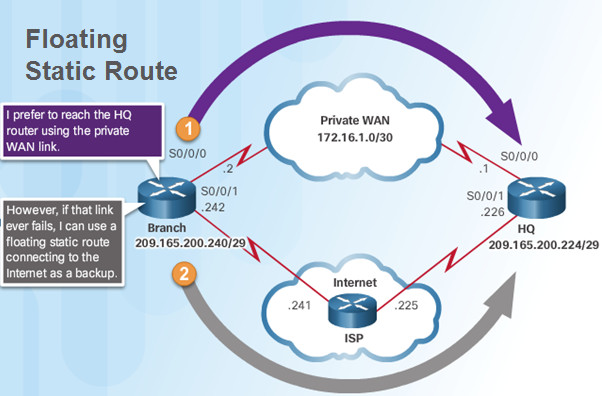
2.2 – Configure Static and Default Routes
2.2.1 – Configure IPv4 Static Routes
2.2.1.1 –ip route Command
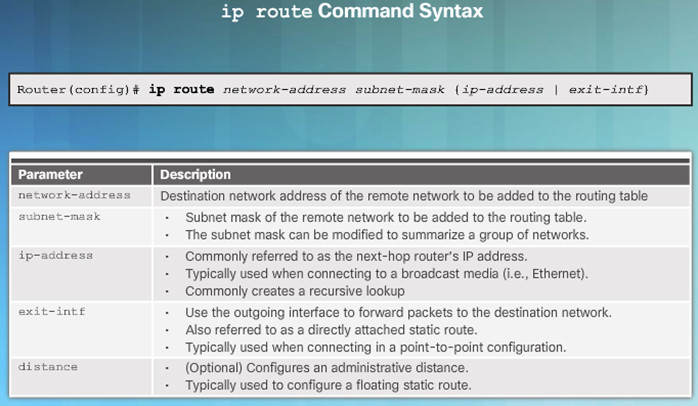
2.2.1.2 – Next-Hop Options
In this example, each router only has entries for directly connected network
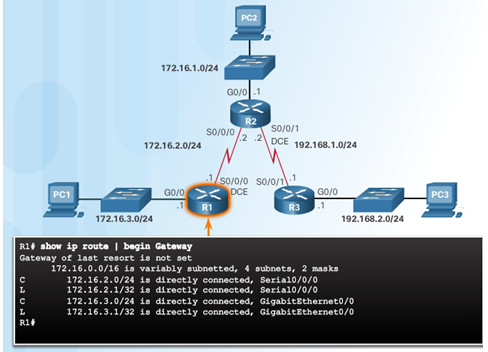

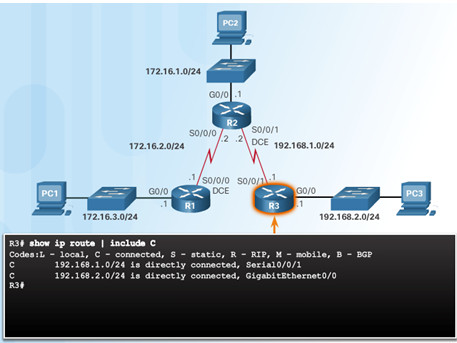
R1 does not have an entry in its routing table for the R3 LAN network
In a static route next-hop can be identified by
Next-hop IP address
Router exit interface
Next-hop IP address and exit interface
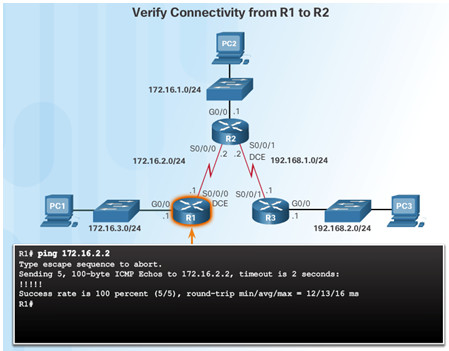
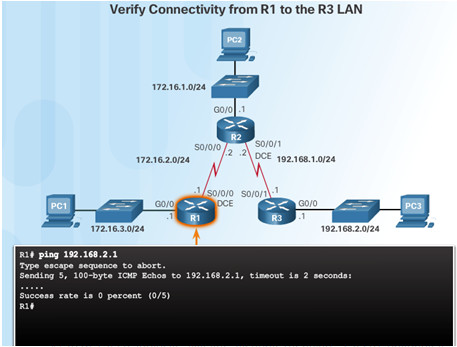
2.2.1.3 – Configure a Next-Hop Static Route
In this example, only the next-hop IP address is specified
Before packet is forwarded the router must determine the exit interface to use (route resolvability)
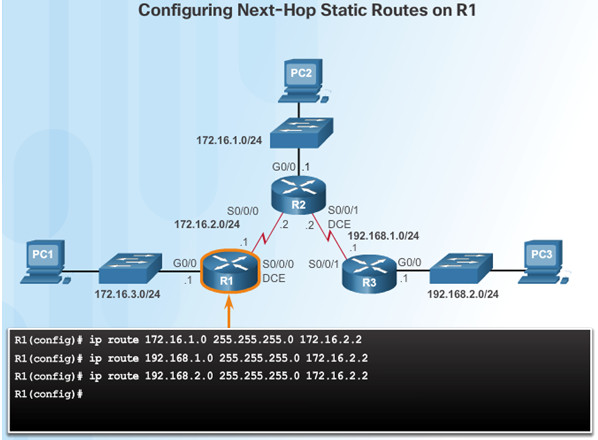
In example, when a packet is destined for 192.168.2.0/24 network, R1:
Looks for match (#1) and needs to forward packets to 172.16.2.2
R1 must determine how to reach 172.16.2.2 first
Searches a second time for 172.16.2.0/24 (#2) and matches to exit interface s0/0/0
Takes two routing table lookups, process referred to as recursive lookup
If the exit interface is “down” or “administratively down” then the static route configured with next-hop will not be installed in routing table
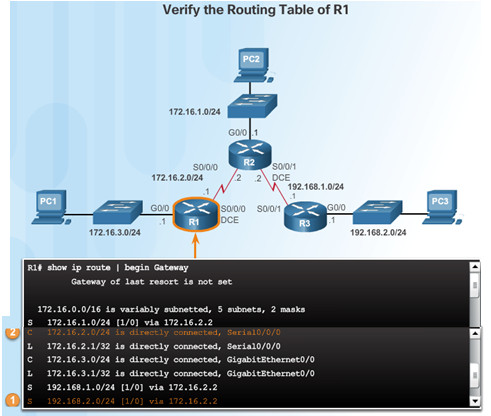
2.2.1.4 – Configure a Directly Connected Static Route
Use the exit interface to specify next-hop so no other lookups are required
Administrative distance of static route is 1
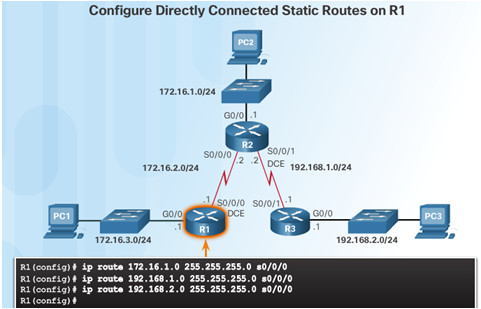
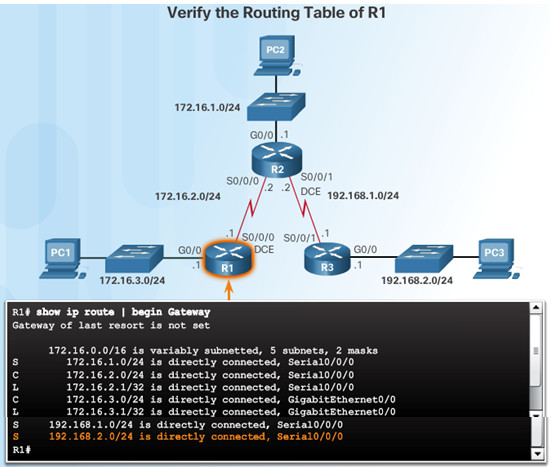
Cisco Express Forwarding (CEF)
- default behavior on IOS 12.0 or later
- provides optimized lookup
- uses a Forwarding Information Base (FIB) which is a copy of the routing table and an adjacency table that includes Layer 2 addresses
- no recursive lookup needed for next-hop IP address lookups
2.2.1.5 – Configure a Fully Specified Static Route
Both the exit interface and the next-hop IP address are specified
When exit interface is an Ethernet network, fully specified static route is used
Note: With CEF, a next-hop address could be used instead
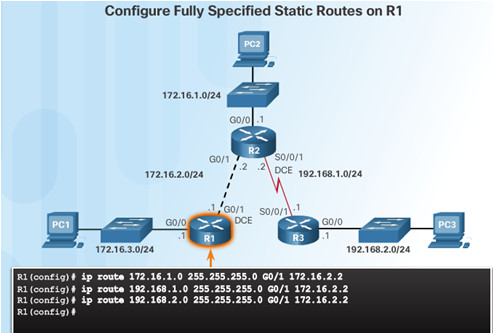
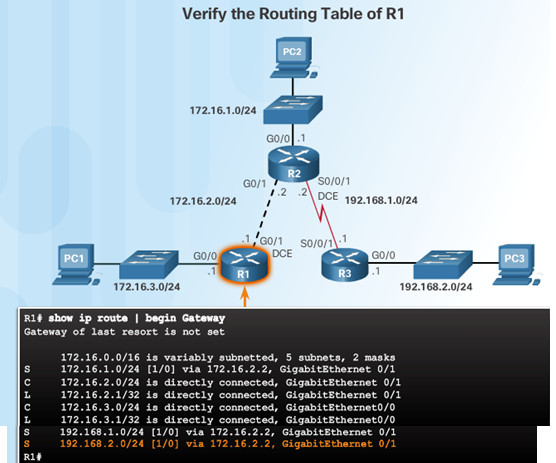
2.2.1.6 – Verify a Static Route
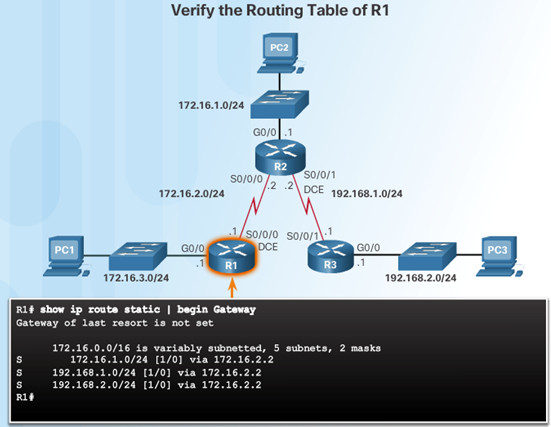
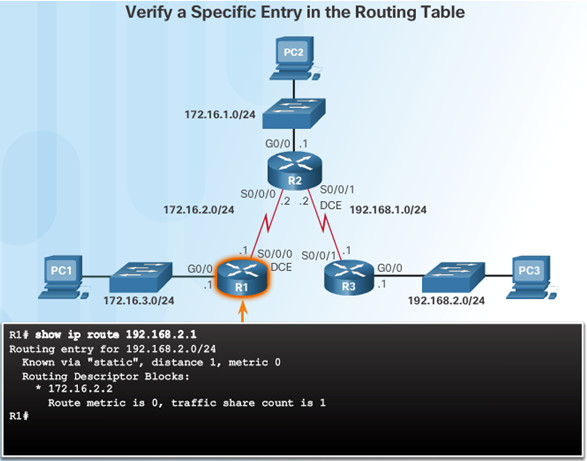
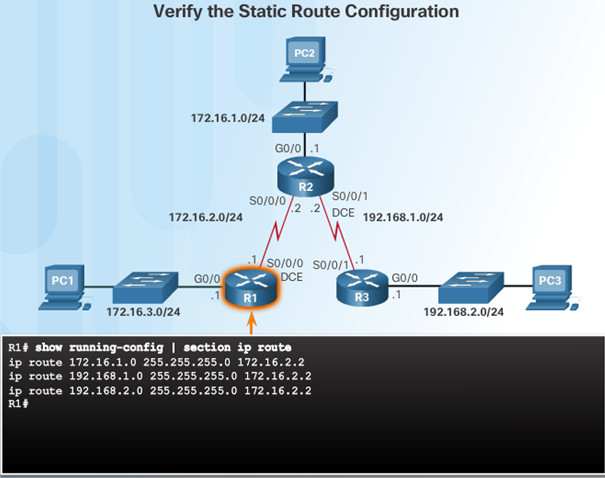
2.2.2 – Configure IPv4 Default Routes
2.2.2.1 – Default Static Route
Default static routes are commonly used when connecting:
- An edge router to a service provider network
- A stub router (a router with only one upstream neighbor router)
Default route is used when no other routes in the routing table match the destination IP
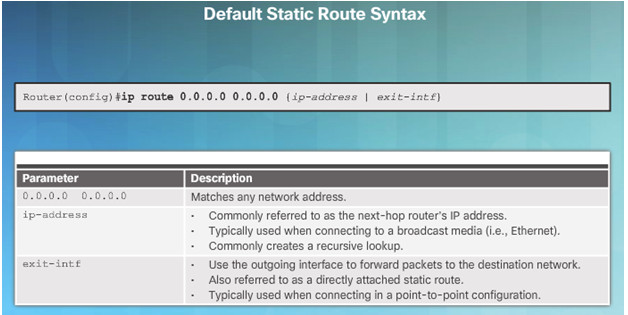
2.2.2.2 – Configure a Default Static Route
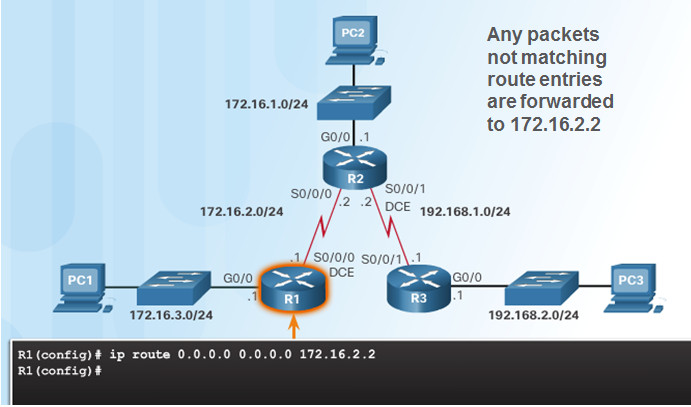
2.2.2.3 – Verify a Default Static Route
show ip route static displays just the static routes
- S indicates static route
- candidate default route indicated by *
- /0 mask in route entry indicates none of the bits are required to match

2.2.2.4 – Packet Tracer – Configuring IPv4 Static and Default Routes
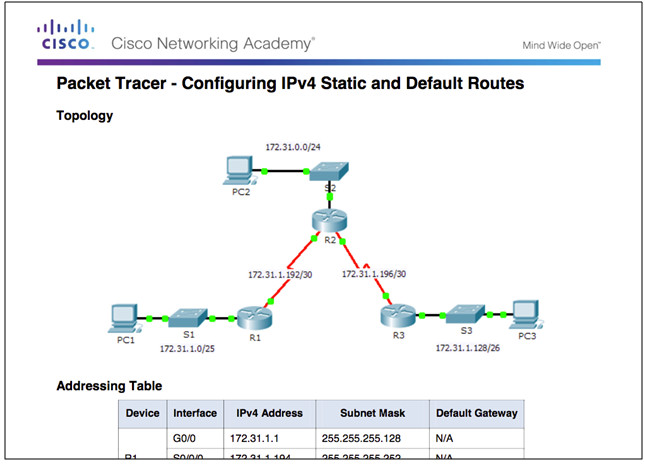
2.2.2.4 Packet Tracer – Configuring IPv4 Static and Default Routes
2.2.2.5 – Lab– Configuring IPv4 Static and Default Routes
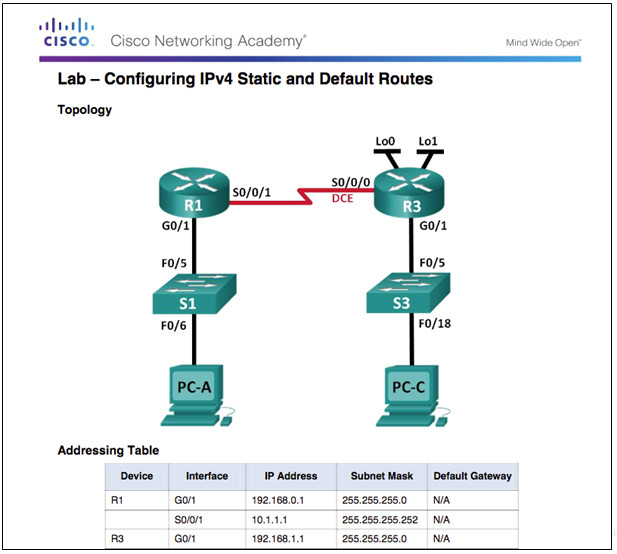
2.2.2.5 Lab – Configuring IPv4 Static and Default Routes
2.2.3 – Configure IPv6 Static Routes
2.2.3.1 – The ipv6 route Command

ipv6 unicast-routing enables the router to forward IPv6 packets
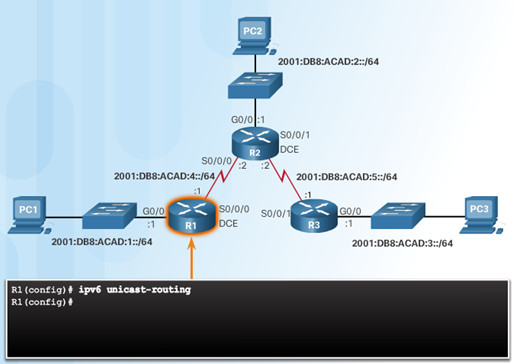
2.2.3.2 – Next-Hop Options
Each router only knows about directly connected networks
- R1 can ping R2 (ipv6 2001:DB8:ACAD:4::2) but cannot ping R3 (ipv6 2001:DB8:ACAD:3::2)
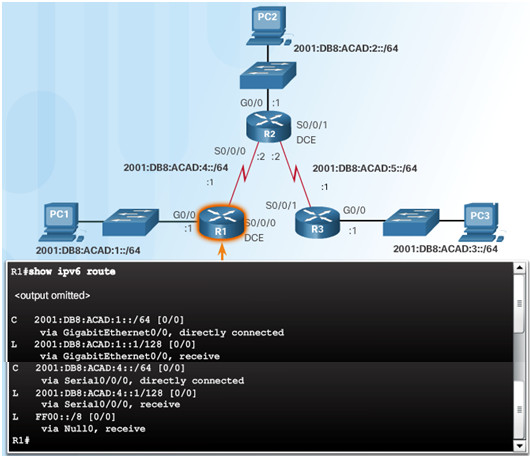
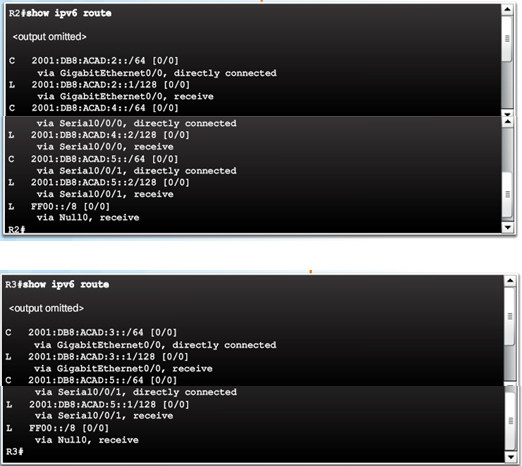
Next hop can be identified by an IPv6 address, exit interface, or both.
Destination is specified by one of three route types:
- Next-hop static IPv6 route – Only the next-hop IPv6 address is specified
- Directly connected static IPv6 route – Only the router exit interface is specified
- Fully specified static IPv6 route – The next-hop IPv6 address and exit interface are specified
2.2.3.3 – Configure a Next Hop Static IPv6 Route
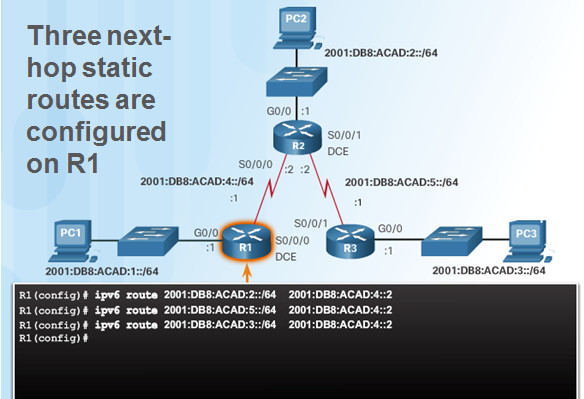
As with IPv4, must resolve the route to determine the exit interface to use to forward the packet
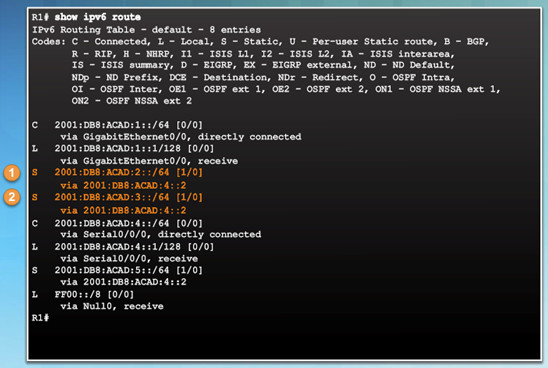
The IPv6 address matches the route for the directly connected network 2001:DB8:ACAD:4::/64 with the exit interface Serial 0/0/0.
2.2.3.4 – Configure a Directly Connected Static IPv6 Route
Alternative to next hop is to specify the exit interface
Packet destined for 2001:DB8:ACAD:3::/64 network, forwarded out Serial 0/0/0 – no other lookups needed
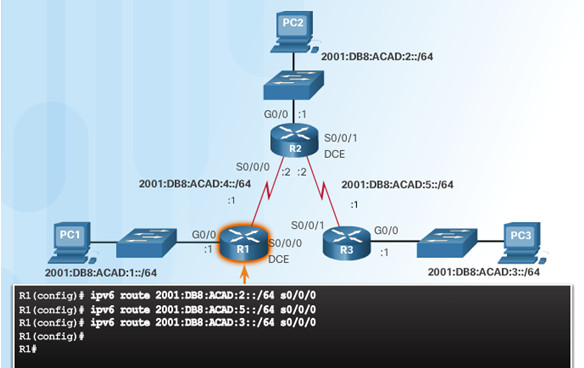
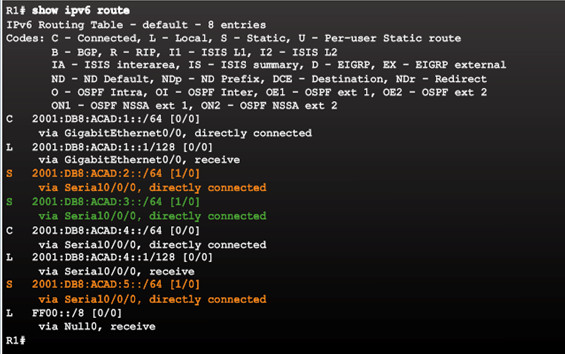
2.2.3.5 – Configure a Fully Specified Static IPv6 Route
Fully specified static route must be used if IPv6 link-local address is used as next-hop
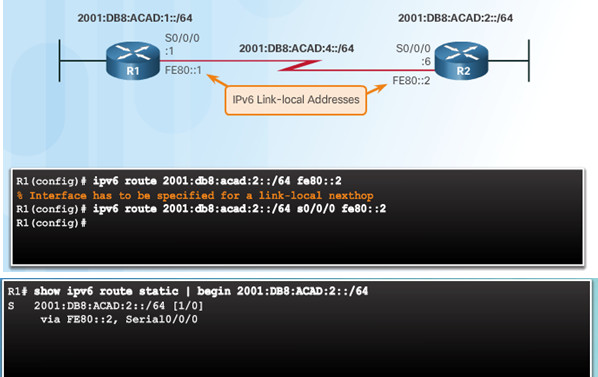
2.2.3.6 – Verify IPv6 Static Routes
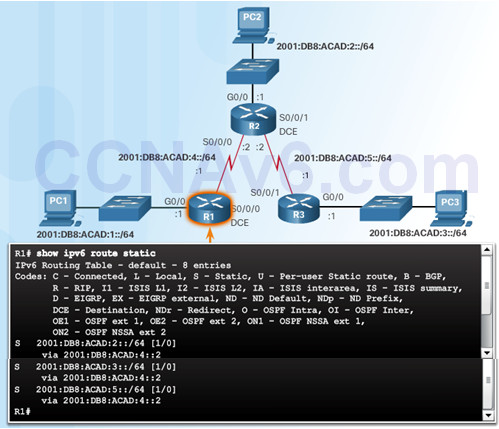
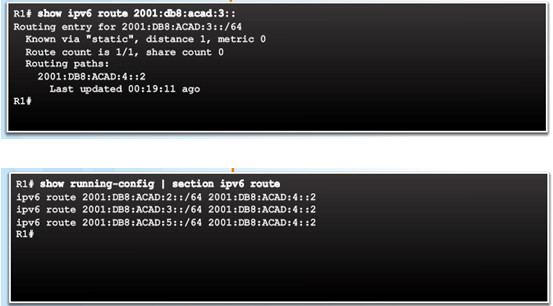
2.2.4 – Configure IPv6 Default Routes
2.2.4.1 – Default Static IPv6 Route
Default static route matches all packets not specified in routing table
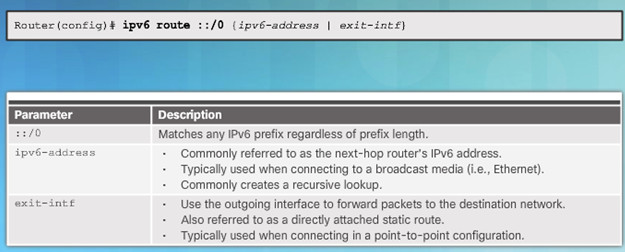
2.2.4.2 – Configure a Default Static IPv6 Route
R1 is a stub router because it is only connected to R2
More efficient to configure a default static IPv6 route in this topology
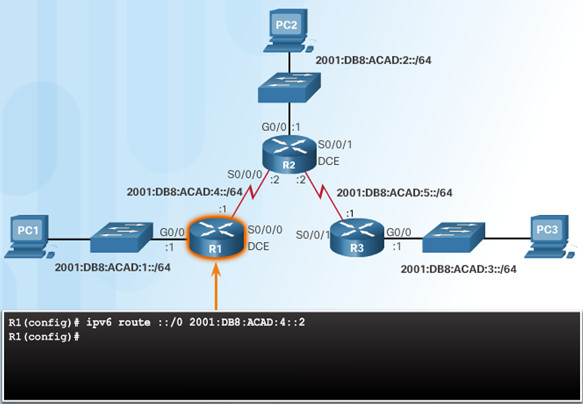
2.2.4.3 – Verify a Default Static Route
::/0 mask indicates that none of the bits are required to match
If a more specific match does not exist, the default static IPv6 route matches all packets.
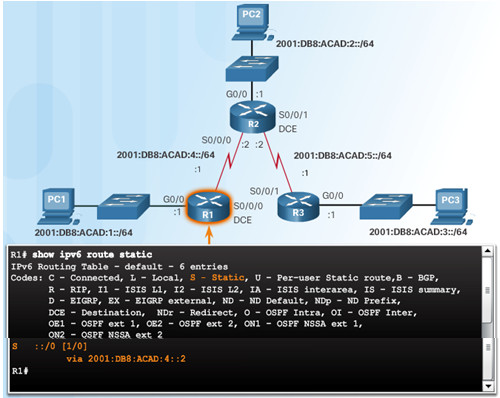

2.2.4.4 – Packet Tracer – Configuring IPv6 Static and Default Routes
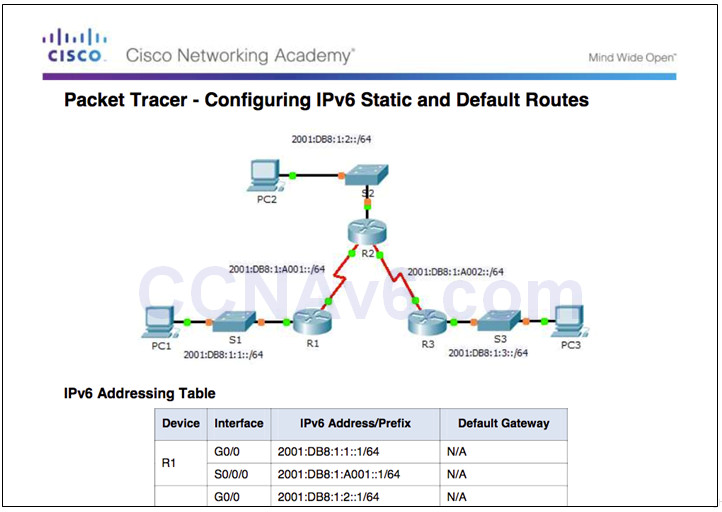
2.2.4.4 Packet Tracer – Configuring IPv6 Static and Default Routes
2.2.4.5 – Lab – Configuring IPv6 Static and Default Routes
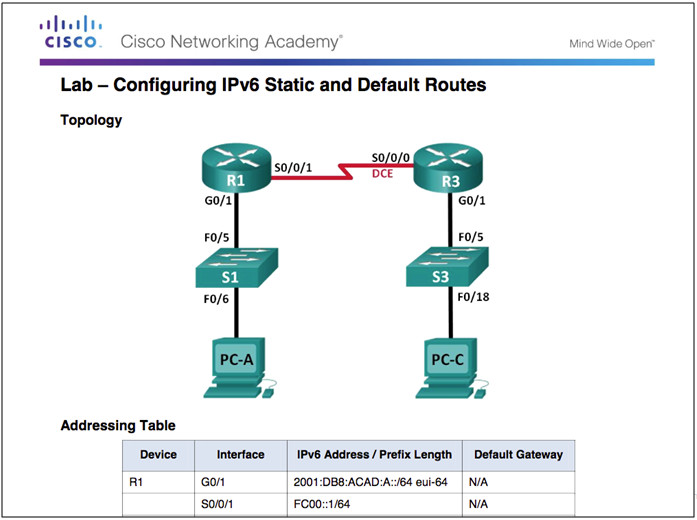
2.2.4.5 Lab – Configuring IPv6 Static and Default Routes
2.2.5 – Configure Floating Static Routes
2.2.5.1 – Floating Static Routes
Floating static routes have an administrative distance greater than the dynamic routing protocol or other static route
Used as backup routes
Administrative distance of common routing protocols
- EIGRP = 90
- IGRP = 100
- OSPF = 110
- IS-IS = 115
- RIP = 120
By default, AD of static route = 1
Static route AD can be increased to make route less desirable until preferred route is lost
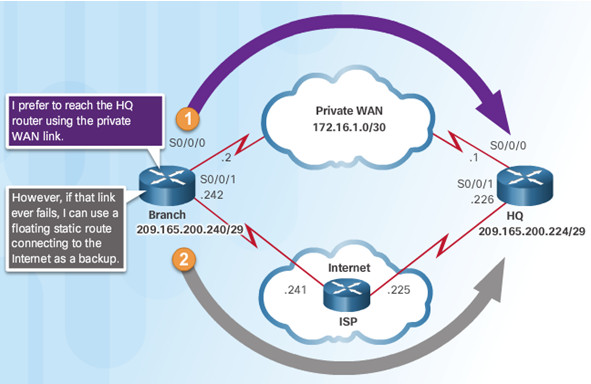
2.2.5.2 – Configure an IPv4 Floating Static Route
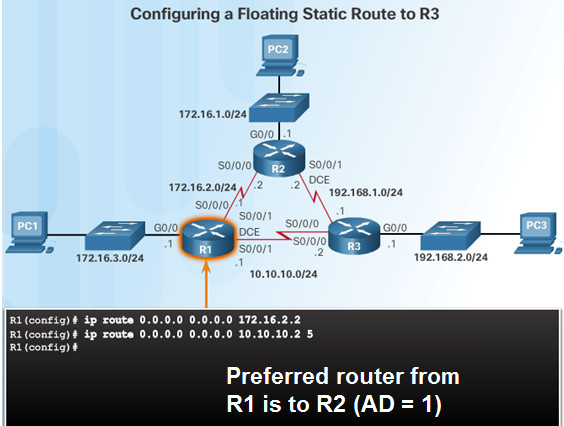

2.2.5.3 – Test the IPv4 Floating Static Route
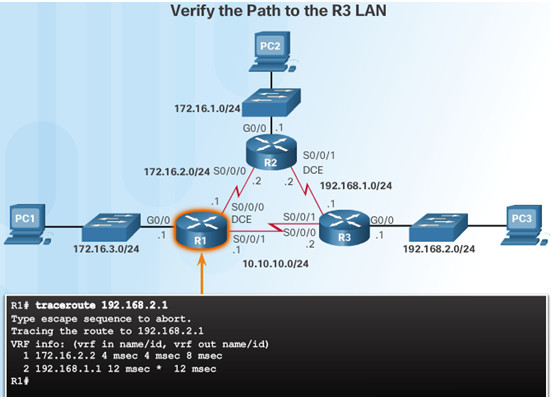

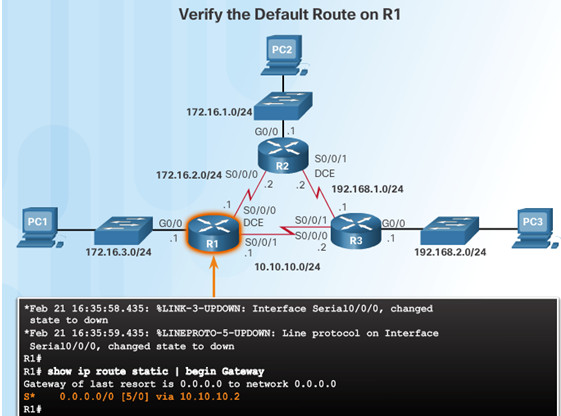

2.2.5.4 –Configure an IPv6 Floating Static Route
Similar to IPv4 floating static routes
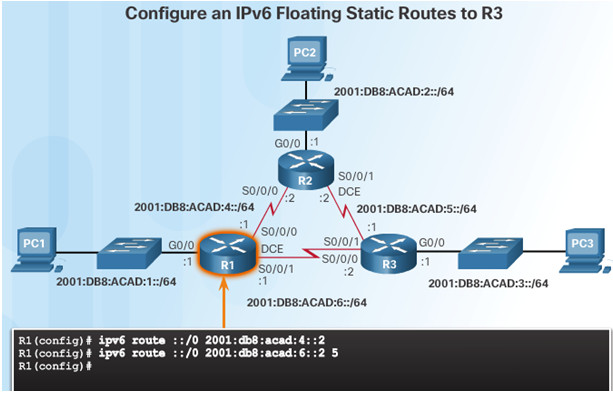

2.2.5.5 –Packet Tracer – Configuring Floating Static Routes

2.2.6 – Configure Static Host Routes
2.2.6.1 – Automatically Installed Host Routes
Host route is an IPv4 address with a 32-bit mask or IPv6 address with a 128-bit mask.
- Automatically installed when IP address is configured
- Configured as a static host route
- Allows more efficiency for packets directed to the router
- Local route marked with “L” (introduced in IOS 15)
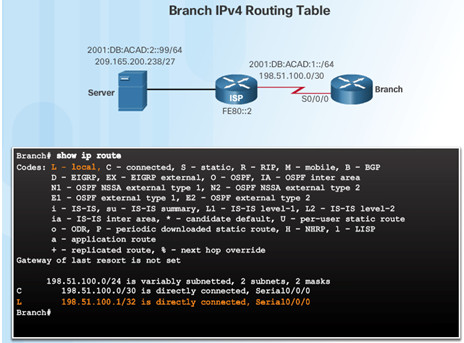
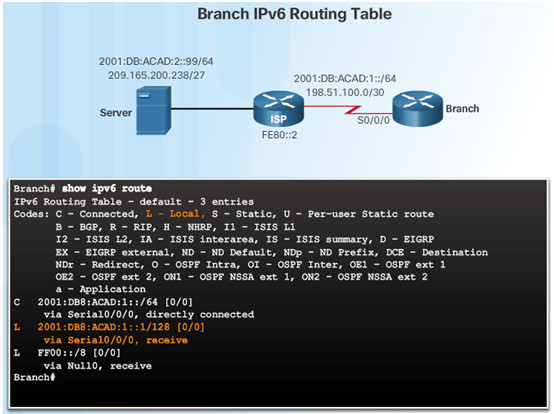
2.2.6.2 – Configure IPv4 and IPv6 Static Host Routes
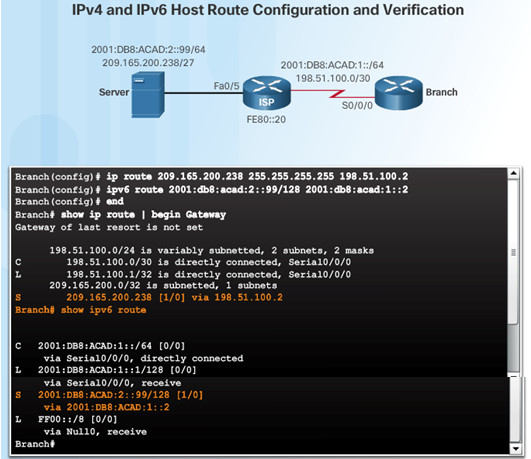
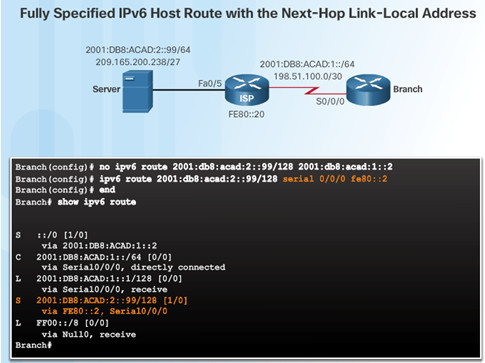
2.3 – Troubleshoot Static and Default Routes
2.3.1 – Packet Processing with Static Routes
2.3.1.1 – Static Routes and Packet Forwarding
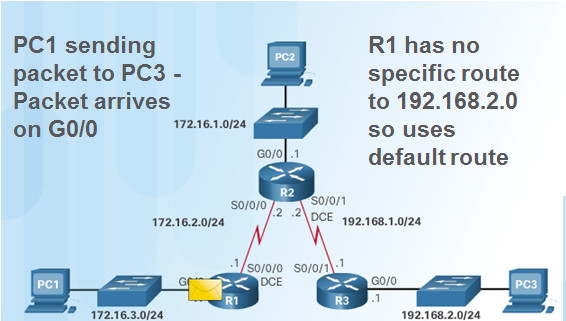
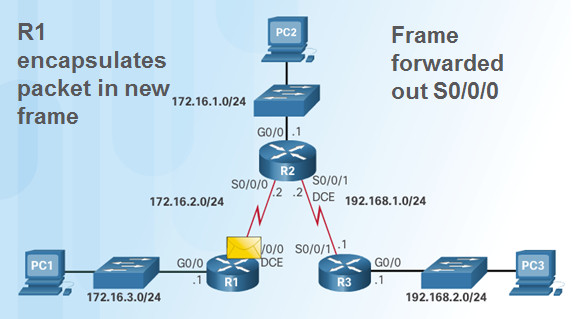
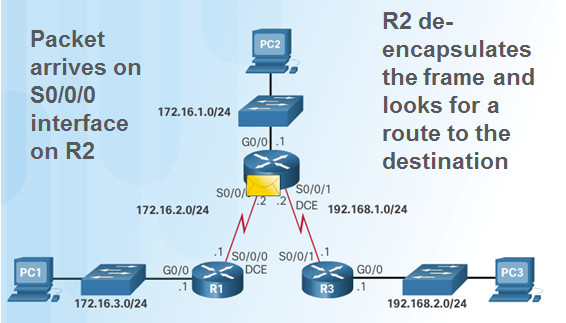
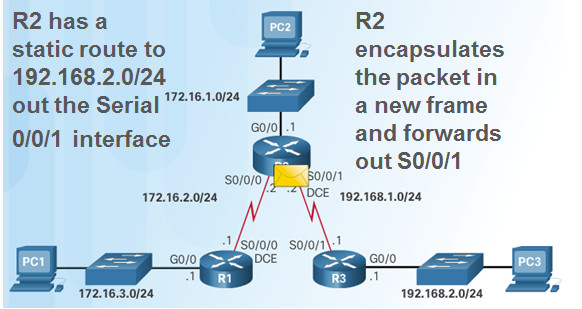
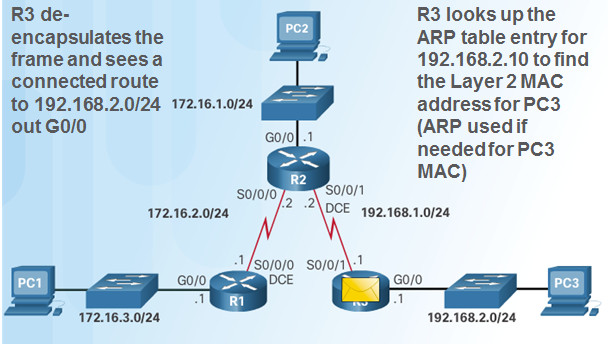
R3 encapsulates the packet in a new frame with the MAC address of the G0/0 interface as the source Layer 2 address and the MAC address of PC3 as the destination MAC address
Frame is forwarded out of G0/0 interface and packet arrives on the NIC interface of PC3
2.3.2 – Troubleshoot IPv4 Static and Default Route Configuration
2.3.2.1 – Troubleshoot a Missing Route
Common IOS troubleshooting commands include:
- ping
- traceroute
- show ip route
- show ip interface brief
- show cdp neighbors detail
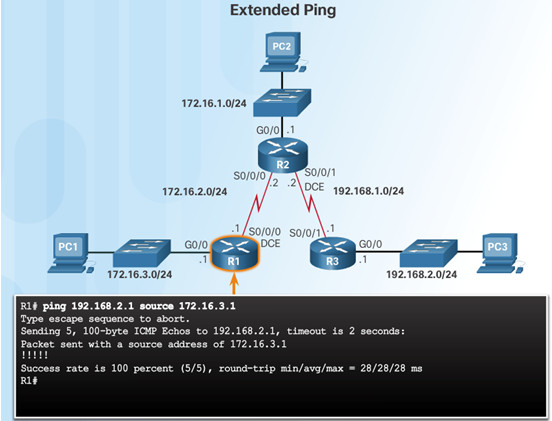

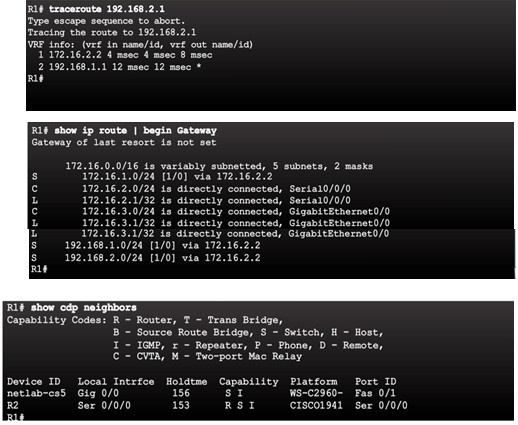
2.3.2.2 – Solve a Connectivity Problem
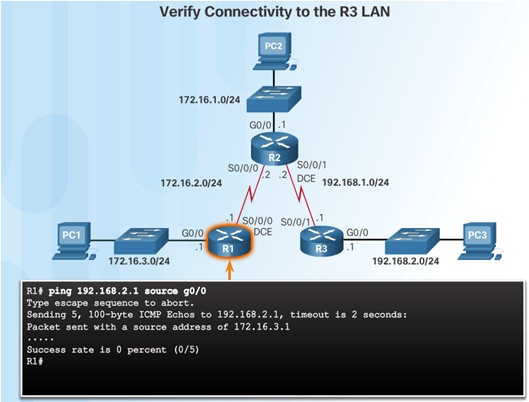
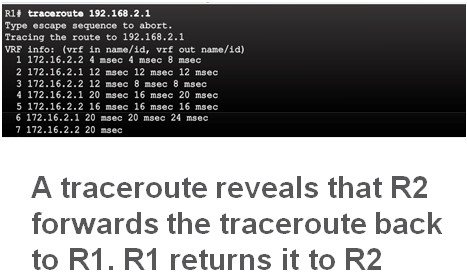
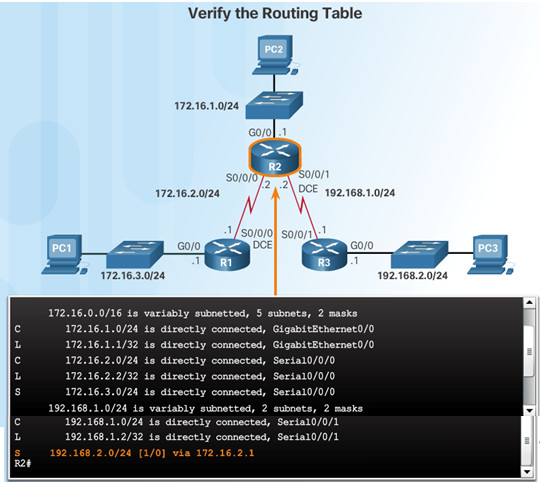
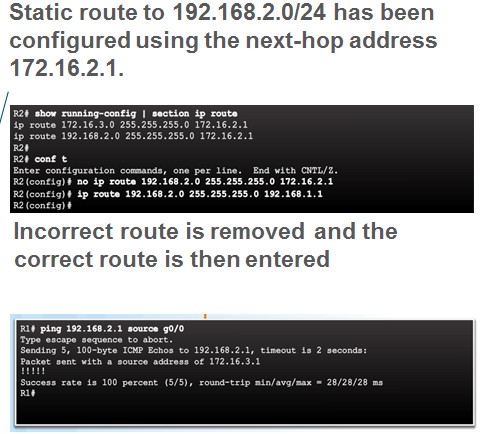
2.3.2.3 – Packet Tracer – Troubleshooting Static Routes
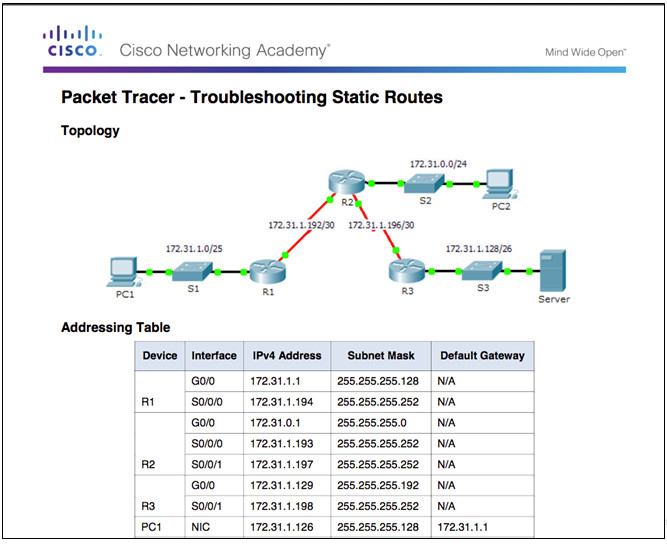
2.3.2.3 Packet Tracer – Troubleshooting Static Routes
2.3.2.4 Lab – Troubleshooting IPv4 and IPv6 Static Routes
2.3.2.4 Lab – Troubleshooting IPv4 and IPv6 Static Routes
2.4 – Summary
2.4.1 – Conclusion
2.4.1.1 Class Activity – Make It Static Instructions
2.4.1.1 Class Activity – Make It Static Instructions
2.4.1.2 – Chapter 2: Static Routing
Explain how static routes are implemented in a small to medium-sized business network.
Configure static routes to enable connectivity in a small to medium-sized business network.
Troubleshoot static and default route configurations.
New Terms and Commands
Section 2.1

Section 2.2

